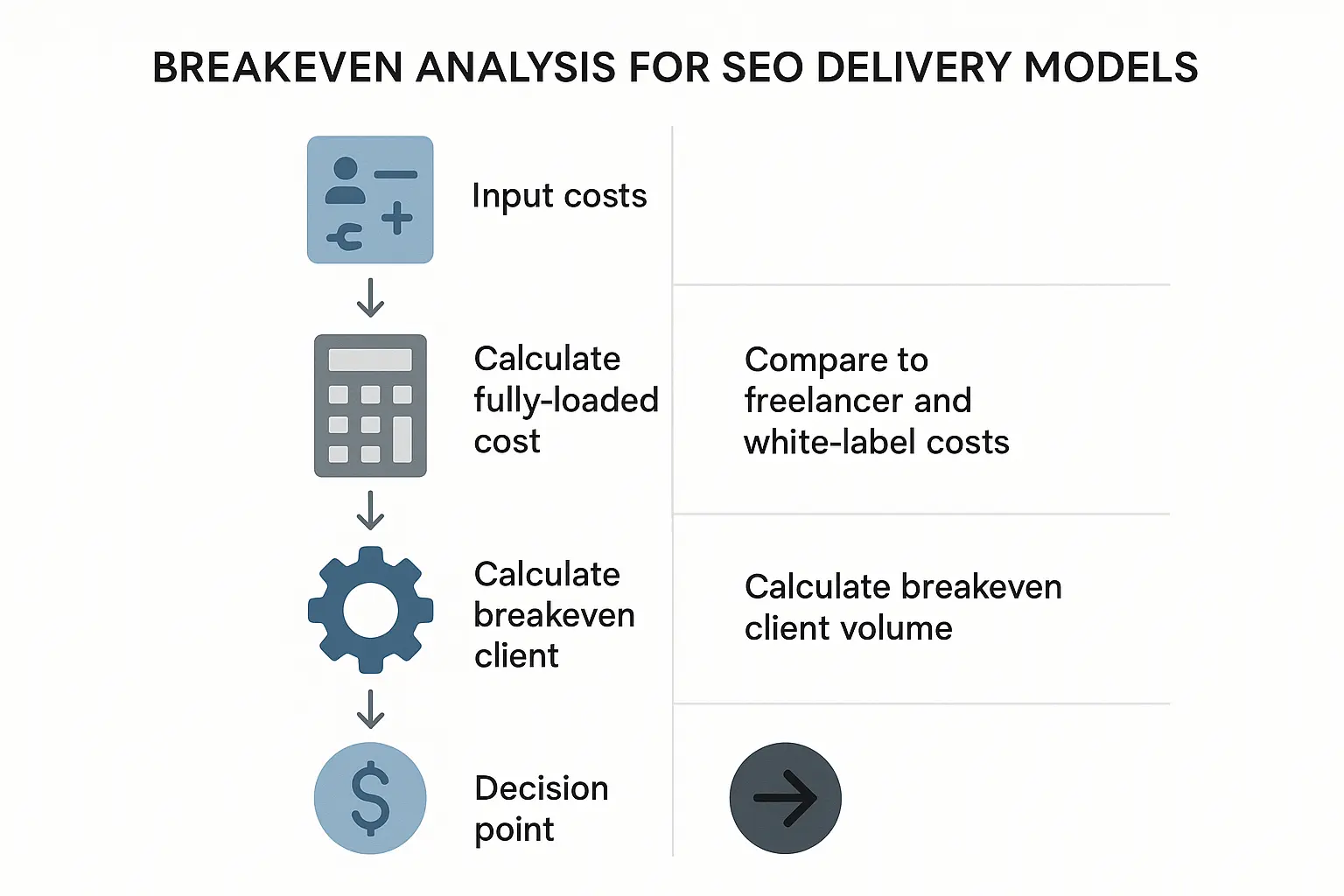You just landed a new SEO client. The contract is signed, the retainer is healthy, and your team is excited. On paper, the project looks like a home run for your agency’s profit margins.
But a few months in, something feels off. Team members seem stretched, project managers are spending more time on SEO oversight than planned, and your tool subscriptions just went up again. When you look at the bottom line, that “profitable” SEO service isn’t contributing as much as you’d forecast.
If this scenario sounds familiar, you’ve encountered the service agency’s trickiest metric: Cost of Goods Sold (COGS). Unlike selling a physical product with clear material costs, calculating the true cost of delivering a service like SEO is a maze of hidden expenses.
Getting it wrong is the fastest way to build a busy—but broke—agency. But get it right, and you unlock scalable, predictable profit.
What is COGS for an SEO Agency, Really?
In a service business, “Cost of Goods Sold” is better understood as “Cost of Revenue” or “Cost of Services.” It represents all the direct costs required to deliver the service your client paid for. The problem is, many agencies track only the most obvious expense: direct labor.
The true COGS for an SEO campaign includes much more:
-
Direct Labor: The salaries of the SEO specialists doing the work.
-
Software & Tools: Your subscriptions for keyword research, rank tracking, site auditing, and reporting.
-
Training & Education: The cost of keeping your team’s skills sharp in a constantly changing industry.
-
Management Overhead: A percentage of the salaries for non-billable staff who support delivery (e.g., project managers, team leads).
Forgetting these “hidden” costs leads to underpricing services, eroding margins, and making it impossible to know which clients are truly profitable. According to a recent industry report, nearly 40% of digital agencies cite managing profitability as a top challenge, largely due to a poor grasp of their delivery costs.
Breaking Down the Three SEO Delivery Models
To protect your margins, you first need to accurately calculate your costs. Let’s break down the COGS for the three most common ways to deliver SEO: building an in-house team, hiring freelancers, or working with a white-label partner.
Model 1: The In-House Team
Hiring an in-house team gives you maximum control, but it also comes with the highest and most complex cost structure.
1. The Cost of Talent (It’s More Than Salary)
The biggest line item is compensation. The average salary for an SEO specialist in the U.S. can range from $60,000 to over $85,000, depending on experience. But the “fully loaded” cost of an employee is typically 1.25 to 1.4 times their base salary.
Let’s do the math for one mid-level SEO specialist at $70,000/year:
Base Salary: $70,000
Payroll Taxes (FICA, etc.): ~$5,355
Health Insurance & Benefits: ~$8,000
401(k) Contribution, etc.: ~$2,100
Total Annual Cost: ~$85,455
This specialist can likely handle 4-6 clients effectively. If they’re at full capacity with five clients, the direct labor COGS per client is already $1,424 per month.
2. The Mandatory Tech Stack
Effective SEO demands a professional toolkit. A single subscription to an all-in-one platform like Semrush or Ahrefs can cost $300-$500 per month. Add a dedicated rank tracker, a reporting dashboard, and a content optimization tool, and your agency’s monthly tool cost can easily top $1,000. Spread across 10 clients, that’s another $100 per client, per month.
3. The “Invisible” Costs: Training and Overhead
SEO is not a “set it and forget it” skill. Google’s algorithm changes constantly. To stay effective, your team needs ongoing education—courses, workshops, and conference tickets can add up to thousands per employee per year.
More importantly, your in-house team requires management. A senior manager or director will spend non-billable hours on strategy, 1-on-1s, and quality assurance. If a manager earning $120,000/year spends just 25% of their time overseeing the SEO team, that’s an additional $30,000 of overhead that needs to be factored into your COGS.

Model 2: The Freelancer Network
Using freelancers seems like a straightforward way to lower costs. You avoid benefits and long-term commitments. However, the COGS calculation here shifts from fixed salaries to variable rates and significant hidden management costs.
1. The Hourly Rate Trap
Experienced SEO freelancers often charge between $75 and $150 per hour. Assuming a project requires 20 hours per month at a blended rate of $100/hour, your direct cost is $2,000 per month. While this looks simpler than a salary, it lacks predictability. A complex technical audit or a content push can cause hours to spike, throwing your margins into chaos.
2. The Management Tax
The single biggest hidden cost of managing freelancers is your own team’s time. Vetting, hiring, onboarding, and managing freelancers is non-billable work. If a project manager spends five hours a month managing a freelancer—communicating briefs, reviewing work, and handling invoices—that’s a significant operational drag. At an internal cost of $80/hour for that PM, you’re adding $400 per month in management overhead to your COGS. This “management tax” is rarely accounted for but can be the difference between profit and loss.
Relying on a network of solo operators also introduces risk. What happens if your go-to freelancer gets sick, takes a vacation, or simply disappears? The scramble to find a replacement creates service gaps and jeopardizes client relationships—a cost that’s hard to quantify but deeply impactful.

Model 3: The White-Label Partner
A white-label partner acts as your invisible, pre-built SEO department. This model is designed to transform the complex, variable COGS of SEO delivery into a single, predictable line item.
1. Fixed, Predictable Costs
With a white-label model, you typically pay a fixed wholesale rate per client campaign. For example, you might pay the partner $1,000/month to deliver a service that you resell to your client for $2,500/month.
Your COGS calculation becomes incredibly simple:
Cost of Delivery: $1,000
Guaranteed Gross Profit: $1,500
This predictability is the primary financial benefit. You know your exact margin on every client, every month, making forecasting, scaling, and sales commissioning straightforward.
2. Eliminating Hidden Expenses
A true agency SEO partner absorbs the hidden costs that crush in-house and freelancer models.
- Tool Subscriptions? Included.
- Team Training? Included.
- Specialist Salaries & Benefits? Included.
- Management Overhead? Included.
Your team’s involvement can then shift from tactical execution and management to high-value client strategy and relationship building. This is a core benefit of SEO outsourcing for agencies, as it frees up your most valuable resources to focus on growth.

The COGS Calculator: Find Your True Profit Margin
Talking about these costs in the abstract is one thing. Seeing them on a spreadsheet is another.
To help you get a clear, unbiased picture of your own numbers, we’ve built an interactive COGS calculator. It allows you to plug in your own data—salaries, tool costs, management time, and freelancer rates—to compare the true cost of all three delivery models side-by-side.
This isn’t a sales tool; it’s a financial clarity tool. Use it to understand your current profitability and model future scaling decisions.
Download Your Free SEO COGS Calculator Template
By understanding your true Cost of Goods Sold, you move from hoping your agency is profitable to knowing it is. You can price your services with confidence, make smarter hiring decisions, and build a scalable foundation for long-term growth.
Frequently Asked Questions (FAQ)
What is the difference between COGS and Operating Expenses (OpEx)?
COGS (Cost of Goods Sold) are the direct costs tied to delivering your service. If you didn’t have a client, you wouldn’t have these costs. Examples include the salary of the SEO specialist working on the campaign and the software used for that client’s reporting. Operating Expenses (OpEx), on the other hand, are the costs of running the business, regardless of clients. This includes expenses like office rent, marketing software, and your accountant’s salary.
Isn’t building an in-house team always the cheapest option in the long run?
Not necessarily. While you avoid paying a partner’s margin, you take on 100% of the risk and overhead. The “fully loaded” cost of an employee—including benefits, training, management, and tools—is often much higher than agencies realize. An in-house team only becomes cost-effective at a certain scale, and even then, it requires significant investment in management and process.
How do I account for my own time if I’m the one delivering the SEO services?
If you’re an owner or a non-dedicated employee doing the delivery, you must “pay yourself” in your COGS calculation. Determine a realistic market rate for your time (e.g., what it would cost to hire someone to do that work) and multiply it by the hours you spend on client execution. Not including this cost will give you an inflated sense of profitability and make it impossible to scale beyond yourself.
What makes a good white-label SEO services partner?
A great partner operates as a true extension of your team. Look for one that provides a predictable cost structure, absorbs all the hidden costs (like tools and training), offers a dedicated point of contact, and delivers all work under your brand. Most importantly, they should have a clear process and proven results, giving you the confidence to sell the service as your own.

